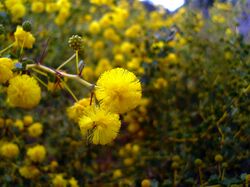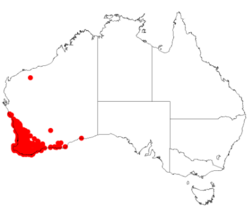Biology:Acacia pulchella
| Prickly Moses | |
|---|---|

| |
| A. pulchella | |
| Scientific classification | |
| Kingdom: | Plantae |
| Clade: | Tracheophytes |
| Clade: | Angiosperms |
| Clade: | Eudicots |
| Clade: | Rosids |
| Order: | Fabales |
| Family: | Fabaceae |
| Subfamily: | Caesalpinioideae |
| Clade: | Mimosoid clade |
| Genus: | Acacia |
| Species: | A. pulchella
|
| Binomial name | |
| Acacia pulchella | |

| |
| Occurrence data from AVH | |
| Synonyms[1] | |
|
Acacia pulchella f. typica E.Pritz. | |
Acacia pulchella, commonly known as prickly moses[2] or western prickly moses,[3] is a shrub in the family Fabaceae. Endemic to Western Australia, it is one of the most common shrubs of the bushland around Perth and in the Darling Range.
Description
The shrub typically grows to a height of 1.5 m (4 ft 11 in) that branches freely and has flexuose and spine tipped pale green branchlets and 1 mm (0.039 in) stipules. The leaves are composed of three to five pinnae.[3] Prickly moses is one of only a small number of Acacia species to have true leaves, rather than phyllodes. It has feathery, bipinnate leaves with leaflets up to 5 mm long. At the base of each leaf is one or two spines. It flowers in late winter and early spring. The rudimentary inflorescences occur in groups of one to three racemose spherical flower-heads with a diameter of about 1 cm (0.39 in) usually containing 10 to 40 but sometimes up to 60 golden coloured flowers. The crustaceous seed pods that form after flowering have a narrowly oblong shape and are flat or slightly undulate with a length of 1.5 to 5 cm (0.59 to 1.97 in) and a width of 3 to 5 mm (0.12 to 0.20 in). The brown seeds inside have a mostly oblong shape and are 2.5 to 4.5 mm (0.098 to 0.177 in) in length.[4] The name "prickly moses" is said to be a corruption of "prickly mimosa".
Taxonomy
It was first described in 1813 by Robert Brown.[5][6]
The specific epithet is derived from Latin and names small and beautiful.[3] There are four recognised varieties:
- A. p. var. glaberrima
- A. p. var. goadbyi
- A. p. var. pulchella
- A. p. var. reflexa
It belongs to the A pulchella group of wattles along with Acacia amputata , Acacia epacantha , Acacia fagonioides , Acacia guinetii , Acacia lasiocarpa and Acacia megacephala.[4]
Distribution
It is found in the Perth, Peel, South West, Great Southern and southern parts of the Wheatbelt and Mid West where it is commonly situated in swamps, low-lying areas and near creeks and rivers.[2] The range of the plant extends from around Geraldton in the north down to near Esperance in the east and to coastal areas in the west and south. Geraldton to Esperance. A single population has also been recorded in South Australia in Creek Conservation Park.[3]
Ecology
Recent research suggests that A. pulchella may in some circumstances suppress the plant pathogen Phytophthora cinnamomi.[7]
Uses
This prickly shrub is useful as a screen to inhibit animal and human access to areas.[8]
See also
References
- ↑ "Acacia pulchella R.Br.". Plants of the World Online. https://powo.science.kew.org/taxon/urn:lsid:ipni.org:names:471259-1. Retrieved 2021-07-14.
- ↑ 2.0 2.1 "Acacia pulchella". FloraBase. Western Australian Government Department of Parks and Wildlife. https://florabase.dpaw.wa.gov.au/browse/profile/3502.
- ↑ 3.0 3.1 3.2 3.3 "Acacia pulchella". Electronic Flora of South Australia species Fact Sheet. Government of South Australia. http://www.flora.sa.gov.au/cgi-bin/speciesfacts_display.cgi?form=speciesfacts&name=Acacia_pulchella. Retrieved 14 February 2021.
- ↑ 4.0 4.1 "Acacia pulchella". World Wide Wattle. Western Australian Herbarium. http://worldwidewattle.com/speciesgallery/pulchella.php. Retrieved 14 February 2021.
- ↑ "Acacia pulchella". Australian Plant Name Index (APNI), IBIS database. Centre for Plant Biodiversity Research, Australian Government. https://biodiversity.org.au/nsl/services/rest/name/apni/69217.
- ↑ Brown, R. (1813). Aiton, W.T.. ed. "Polygamia monoecia". Hortus Kewensis 5: 464. https://www.biodiversitylibrary.org/page/48025071.
- ↑ Arunodini Jayasekera, Interactions between Phytophthora cinnamomi and Acacia pulchella: consequences on ecology and epidemiology of the pathogen, Murdoch University, Western Australia, PhD thesis 2006
- ↑ "York gum species list". Toodyay Land Conservation District Committee. Archived from the original on 2014-01-25. https://web.archive.org/web/20140125144007/http://toodyaylandcare.org.au/yorkgum%20species%20list.htm.
External links
| Wikimedia Commons has media related to Acacia pulchella. |
- "Acacia pulchella". Flora of Australia Online. Department of the Environment and Heritage, Australian Government. http://www.anbg.gov.au/abrs/online-resources/flora/stddisplay.xsql?pnid=.
Wikidata ☰ Q1280904 entry
 |



